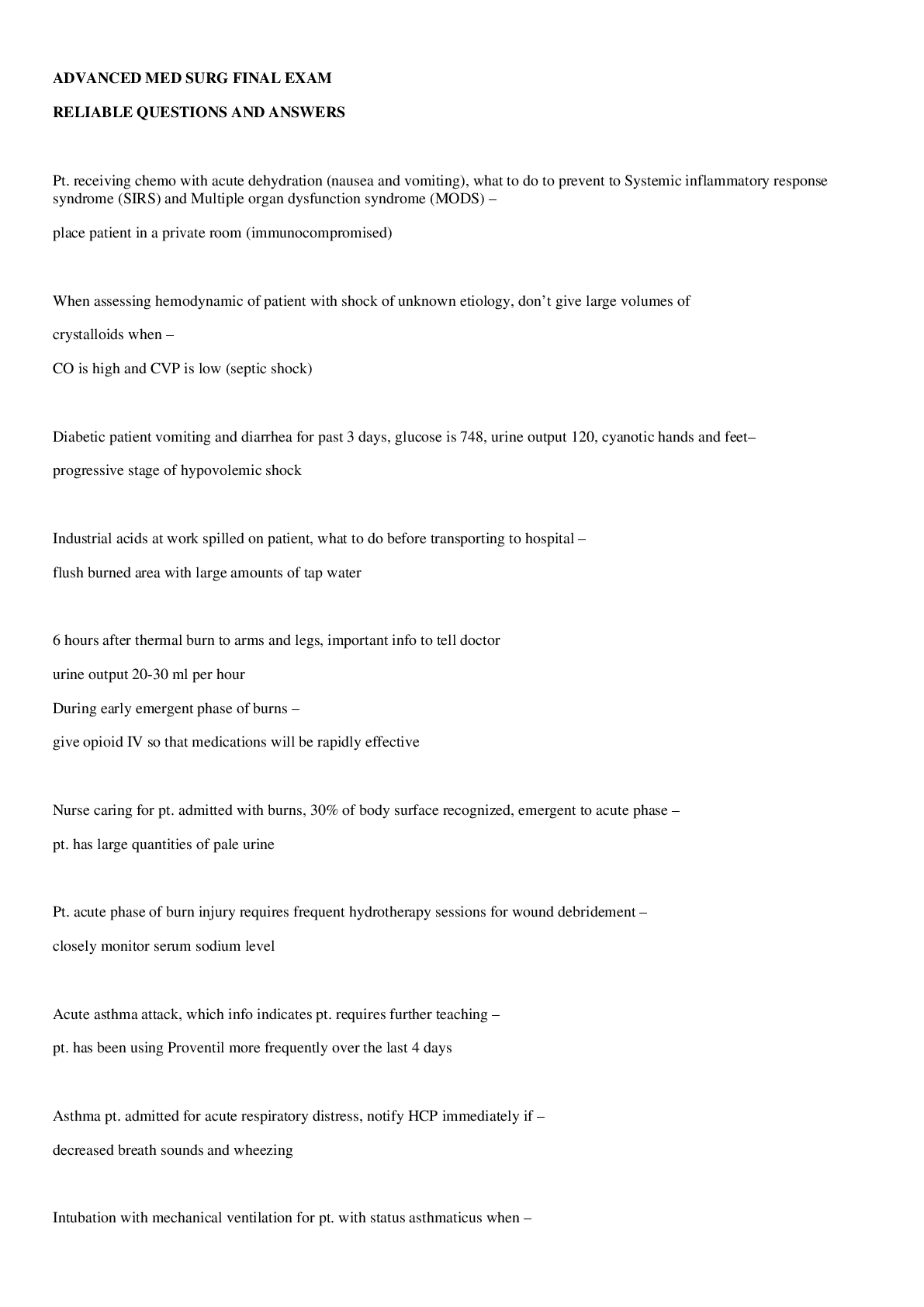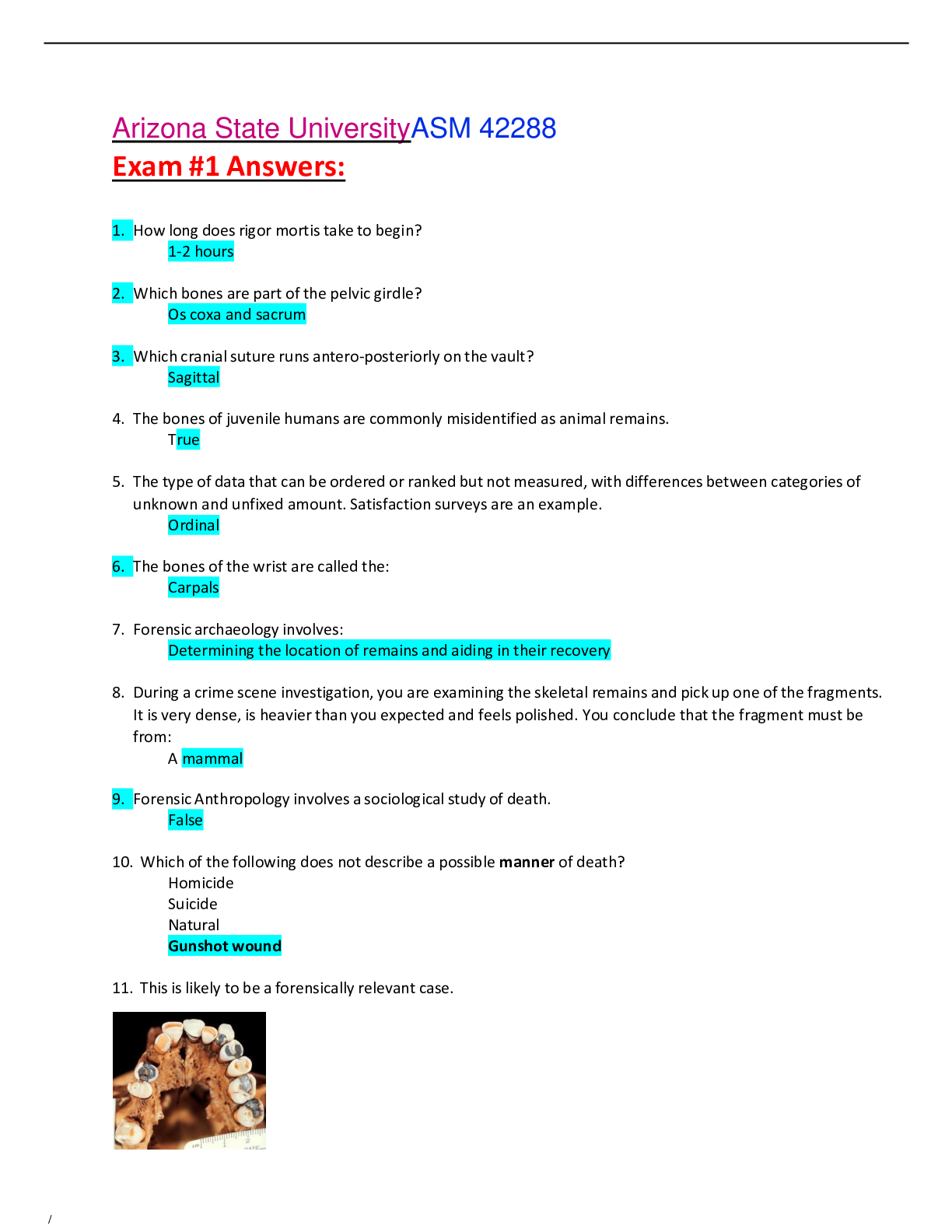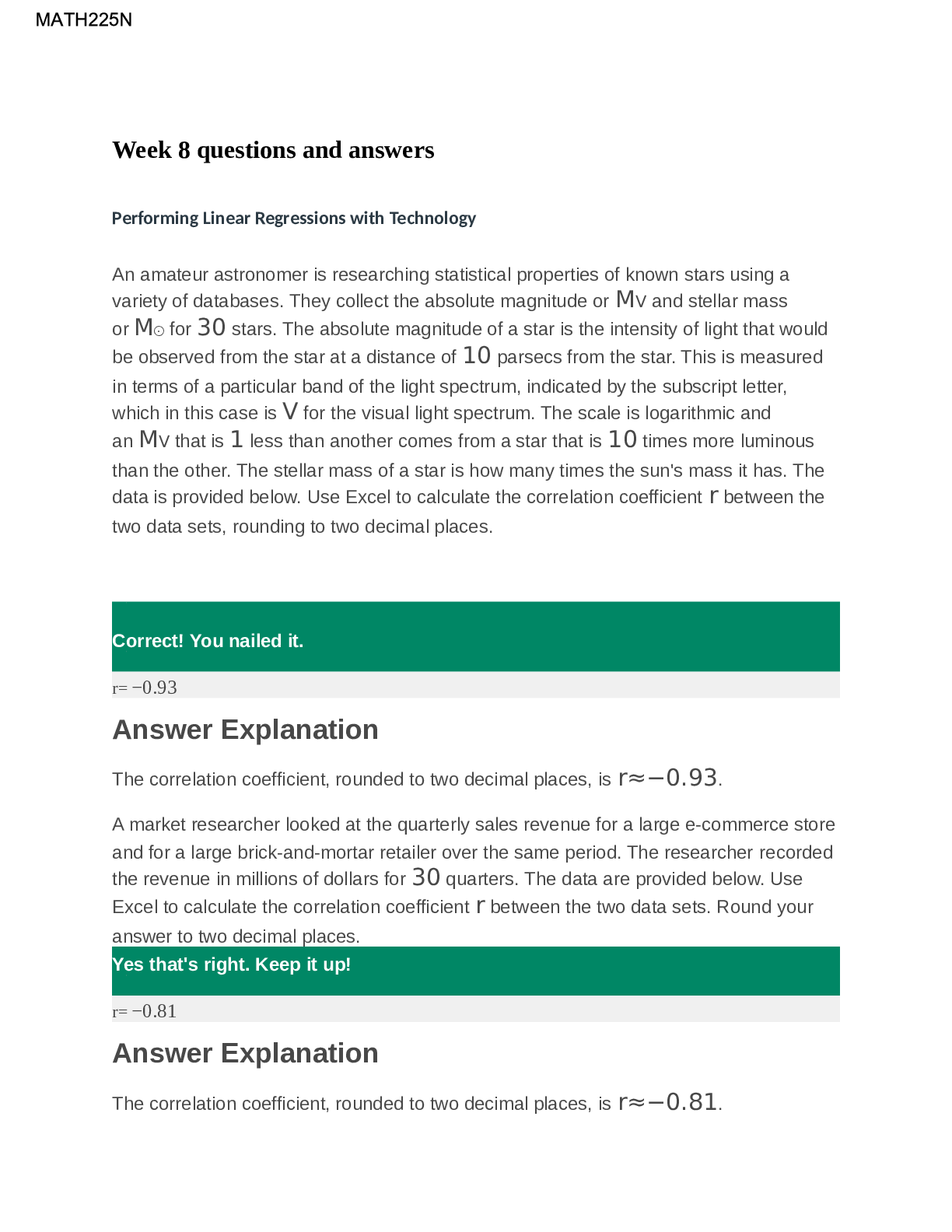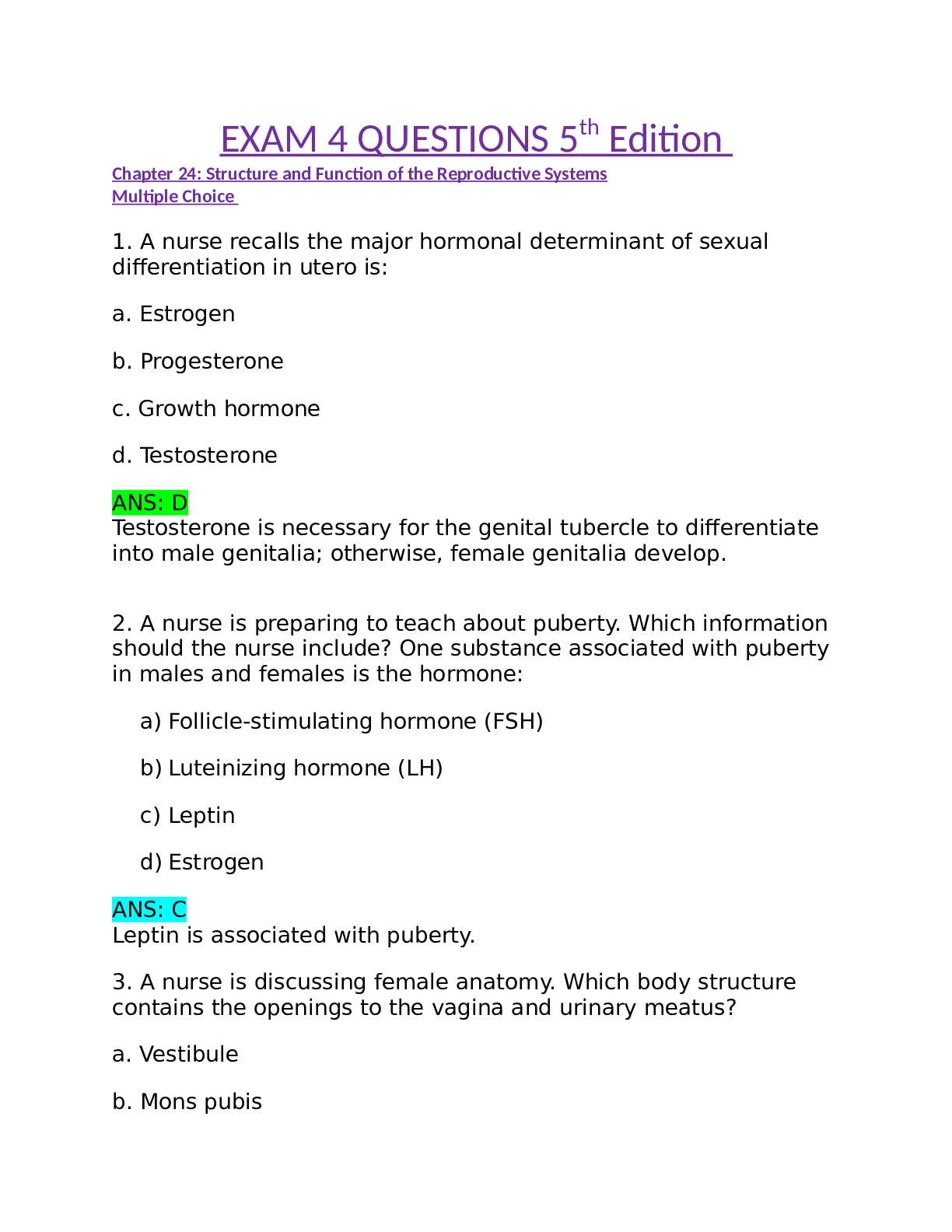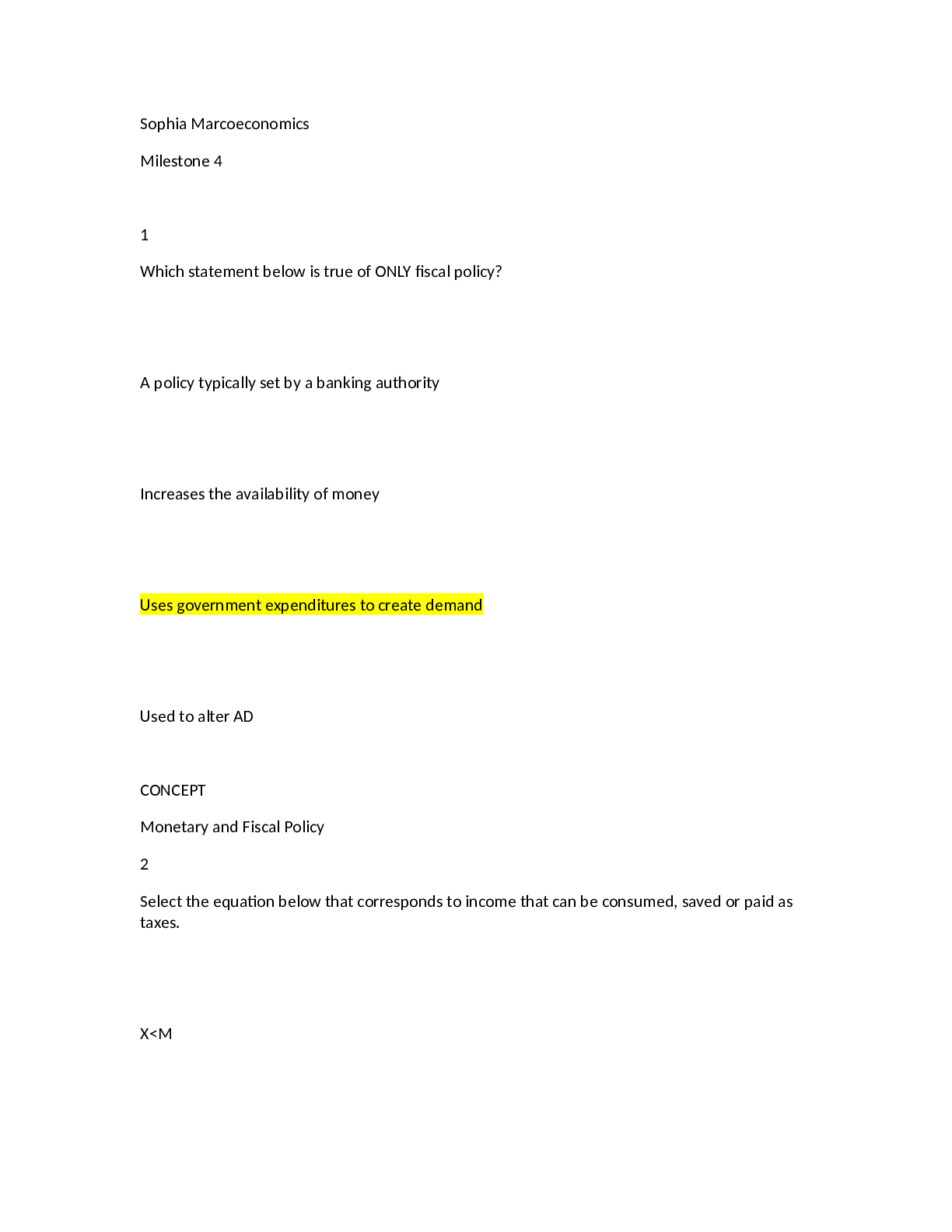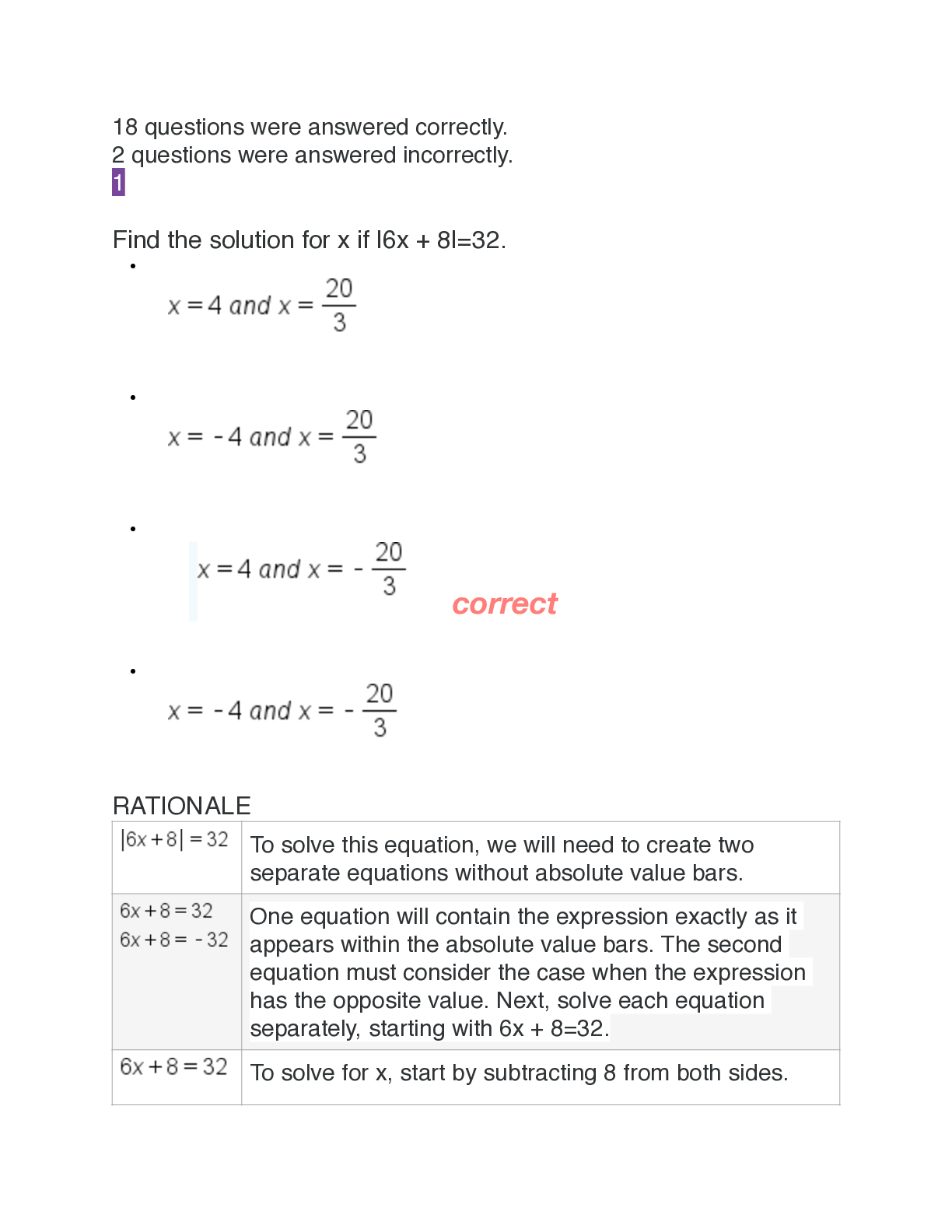BioChemistry > QUESTIONS & ANSWERS > University of New England Biochemistry 1005 Questions and Answers Latest 2022 Rated A (All)
University of New England Biochemistry 1005 Questions and Answers Latest 2022 Rated A
Document Content and Description Below
Unit 2: Week 7: Session Objectives: 1 Define and briefly explain the role of entropy, and enthalpy in biochemical reactions Enthalpy (∆H) is the change in chemical bond energy in a reaction (bo... nd energy of products minus the bond energy of reactants). Also called HEAT CONTENT. Entropy (∆S) is a measure of disorder. It is often negligible in reactions (ATP hydrolysis) in which the number of reactants and products are equal (and no gas is formed). 2 Give examples of biochemical, mechanical and transport work. Mechanical work > the high energy phosphate bond of ATP is converted into movement by changing the conformation of a protein (ex. myosin head group) Transport work (active transport) > ATP is used to transport a compound against its [ ] gradient. (EXAMPLE: ATPASES) Biochemical Work> formation of chemical bonds. would be unfavorable without using ATP and the removal of products (intermediates that continue down the pathway) and accumulation of more substrates (EXAMPLE ENGERY OF REACTION) 3 Calculate the overall delta G of a series of reactions if given the delta G for each individual reaction Just add all of them together, summative 4 Describe the role of ATP as an energy carrier, specifically the role of the high energy phosphate bonds (Figure 19.2) Bonds between the phosphate groups are called Phosphoanhydride bonds. ATP unstable because the closely grouped negative phosphate groups (repel and strain) When those bonds are broken (Hydrolysis), energy is released (products>ADP and phosphate are more stable) Release energy as HEAT. BUT in the cell it is NOT hydrolyzed directly (heat is inefficient for transfer to energy requiring processes. INSTEAD enzymes transfer the phosphate group directly to metabolic intermediates or proteins (phosphoric transfer reaction) to drive their reactions forward. 5 Compare the redox coenzymes, FAD, NAD and NADPH as the cell's electron carriers (Figure 19.9, 19.10) -NAD⁺ accepts two e as a HYDRIDE ion (H ⁻ ⁻¹ ) to form NADH, and a proton is released into the medium. Usually involved in oxidation of ALCOHOLS and ALDEHYDES. FAD accepts two e as hydrogen atoms (w/1 e each), which are ⁻ ⁻ donated from separate atoms. INVOLVED in the formation of a double bond or a disulfide. forms FAD(2H). Listed as FAD(2H), because it often accepts a total of 2 e , one at a time, never going to the fully reduced ⁻ state (FADH )₂ NADP⁺ is similar to NAD and has the same reduction potential, BUT it ⁺ has an extra phosphate group on the ribose. Affects its enzyme binding. Most enzymes use either or, but not both. Used by glucose 6P dehydrogenase to transfer e from glucose 6P to NADP (instead of ⁻ ⁺ NAD ). NADPH usually donates e to biosynthetic runs, such as fatty ⁺ ⁻ acid synthesis and detoxification rxns that use O directly.(i.e. its ₂ reduction potential is usually used in rxns directly without first being converted to ATP). As the reduced coenzymes donate these electrons to O , through the ₂ ETC, they are reoxidized. 6 Define oxidation, reduction, reducing agent and oxidizing agent. -FAD and NAD are reduced by the transfer of e from a compound as ⁺ ⁻ Hydrogen (w/ 1 e for FAD from 2 atoms separately) or Hydride (w/2e ⁻ ⁻ for NAD ) ⁺ If something is reduced, something else is oxidized. NAD , NADP and FAD are the oxidized forms and NADH, NADPH, ⁺ ⁺ FAD(2H) are the reduced forms. 7 Describe the purpose of Complexes I, III, and IV in oxidative phosphorylation and ATP synthase in ATP generation (Figure 21.1). -Complex I: NADH:CoQ oxidreductase -Binds NADH, passes two electrons to FMN. Fe-S centers. -Fe-S centers can transfer electrons to Coq (2 e-) -Moves 4 protons to the intermembrane space (the 2 efrom CoQ) -Complex III: Cytochrome b-c complex -Uses Heme Fe complex: Fe3+ reduced to Fe2+ (as electrons move down the chain) -Complex IV: Cytochrome oxidase -Last cytochrome must transfer 4 electrons to oxygen -Does this using copper ion. 8 Relate the proton motive force to the pH on either side of the mitochondrial membrane (Figure 21.2) Proton motive force is the electrochemical gradient. Consists of the MEMBRANE POTENTIAL (∆φ) AND the PROTON GRADIENT (∆pH) Called the proton motive force because it represents the potential energy driving protons to return to the more negatively charged alkaline matrix. pH is higher on the cytosolic side (0.75pH difference in actively respiring mitochondria) Cytosolic side is the inter membrane space The reduction potential of each complex of the ETC is at a lower energy level than the previous complex, so energy is released as E 's pass ⁻ through each complex. THIS ENERGY is used to move protocols again their concentration gradient. 9 Describe the role of Complex II (succinate dehydrogenase) in the electron transport chain (Figure 21.5) Binds FADH. Also part of the TCA cycle. Transfers e 's to IronSulfur (Fe ⁻ S) center and then to CoQ. Is Not Transmembrane (NO PROTON PUMPING ABILITY.) 10 Discriminate between electron transport inhibitors and uncouplers of oxidative phosphorylation Inhbitors: Block electron transport. No ATP generation and No O ₂ Consumption. They stop the passing of electrons from one subunit to another. Uncoupler: Dissipates the proton gradient ∴ No ATP generation. BUT results in increased oxygen consumption and head production. Can be chemical uncouplers (proton ionophores) or uncoupling proteins (UCPs) 11 Determine the impact of the addition of an inhibitor or an uncoupler on the electron transport chain, oxygen consumption and ATP production. Inhibitor: No O2 or ATP generation. Stops ETC completely. Uncoupler: Higher O2 consumption, no proton gradient (no ATP) 12 Explain how electron transport and ATP synthase are functionally coupled -Electron flow requires proton pumping, so electron flow cannot occur faster than protons are used for ATP synthesis As more ATP is used (Exercise), ADP and Pi concentrations build up. The more ADP is present to bind to ATP synthase, the greater the proton flow will be through the ATP synthase pore > Electrochemical gradient decreases>Increases O consumption, and increased oxidation of ₂ NADH>Increased build oxidation in TCA cycle. 13 Describe the role of the malate aspartate shuttle (22.8) in moving cytosolic NADH into the mitochodria and transporting aspartate ouf of the mitochondria -1 of two shuttles for NADH Necessary b/c inner mito membrane is impermeable to NADH NADH reduces Malate, which can move across the membrane into the mito matrix. Malate is then oxidized (in the matrix), to oxaloacetate. Malate reduces NAD to NADH in the matrix for the ETC. ⁺ Malate (In the Matrix) is Transaminated (TA) to Aspartate, which can then pass back out the Matrix 14 Describe how the glycerol 3-P shuttle (Figure 22.7) moves cytosolic NADH into the mitochondria -Cytosolic NADH (Produced from the oxidation of glucose), cannot be transported across the inner mito membrane. So NADH is used to create Glycerol 3Phosphate, which can defuse across the membrane. Once in the membrane, Glycerol donates those e 's to FAD (to generate ⁻ FAD(2H)) which is accepted by succinate dehydrogenase (Complex II) 94 Identify compounds that can and cannot move freely across the mitchondrial membrane. Week 8: Session 1 Objectives: 15 List the fates of glucose, amino acids and fats after a meal Glucose: Oxidation, Storage, and synthesis. - Oxidation: Dietary carbohydrates are mostly broken down to this major monosaccharide in the blood, then oxidized to CO2 for energy, Storage: excess stored as glycogen or TAG (Triacylglycerol), which can later be converted to glucose. Note that fatty acids cannot be converted back to glucose. - Synthesis: of many compounds as it is the major biosynthetic precursor for most bodily compounds - Glucose can be taken up by liver, activates glycogen synthesis, fatty acid synthesis, and protein synthesis. Dietary fuel, triggers insulin to release. Amino Acids: Synthesis, Oxidation, and Gluconeogenesis. -Protein Synthesis: various -Synthesis of Ncontaining compounds: in cells, like neurotransmitters, heme -Oxidation: proteins may be used for energy for aerobic use or converted to glucose -Gluconeogenesis: in liver cells to maintain blood sugar levels. -Go into primarily into liver and skeletal muscle. -Part of the anabolic pathway. Fats: Storage, oxidation, and synthesis. -Storage: as TAG (Triacylglycerol) -Oxidation: for energy (mainly carbons) -Synthesis: source of building blocks for membrane lipids like phospholipids 16 Describe anabolic vs catabolic processes. Anabolic Processes: High levels of glucose and insulin: triglyceride synthesis, glycogen synthesis, and active glycolysis. Processes create complex materials from simpler substances. This activity would include synthesizing the basic components of cells like proteins and lipids, as well as creating the storage form of nutrients to be utilized as needed for energy. The steroidal hormones that stimulate protein synthesis and muscle growth are traditionally classified by endocrinologists as anabolic hormones due to the nature of their effects on the body. Catabolic Processes: Low levels of glucose/insulin: Glycogen degradation, gluconeogenesis. Processes move in the opposite direction, breaking down large molecules into smaller ones, and tend to release energy in the form of energy rich compounds like adenosine triphosphate (ATP). They not only supply the energy to power anabolic activity, they also provide the small molecules (building blocks) required to create more complex molecules, and the electrons which act like “glue” by holding atoms together through chemical bonds. 17 Determine the impact of glucagon, insulin, cortisol and epinepherine on the liver, skeletal muscle, and adipose tissue Liver: -Glucagon: Activates glycogenolysis (conversion of glycogen to glucose, which is release by liver to provide substrate to tissues [Show More]
Last updated: 1 year ago
Preview 1 out of 21 pages
Instant download

Buy this document to get the full access instantly
Instant Download Access after purchase
Add to cartInstant download
Reviews( 0 )
Document information
Connected school, study & course
About the document
Uploaded On
Apr 19, 2022
Number of pages
21
Written in
Additional information
This document has been written for:
Uploaded
Apr 19, 2022
Downloads
0
Views
66

.png)
.png)
.png)
.png)
.png)
.png)
.png)
.png)
.png)
.png)
.png)



